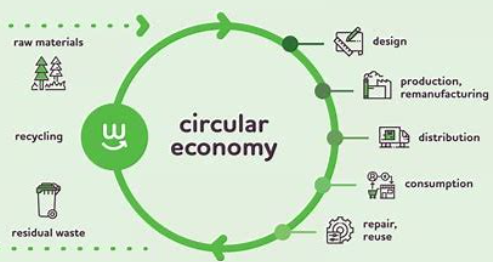A Route to Achieving Sustainability
Introduction: The emergence of the concept of a circular economy is a transformative solution to address urgent environmental concerns and the need for sustainable development. The circular economy diverges from the conventional linear economic model, characterised by a “take-make-dispose” approach, by striving to establish a closed-loop system that maximises resource utilisation and minimises waste production.
Principles: The circular economy is supported by many essential guidelines:
The design of products prioritises longevity, reparability, and recyclability, which increases their lifespan and makes it easier to recover resources.
The focus is on prolonging the lifespan of things by repairing, refurbishing, and reusing them, hence minimising the demand for new resources.
Resource efficiency refers to the practice of maximising the utilisation of resources and minimising the development of waste by effectively managing resources and optimising the flow of materials.
Recycling and regeneration involve the recovery and regeneration of materials and components, which are then used to create new goods or returned to the ecosystem. This process operates in a closed-loop system, which helps reduce the dependence on new resources.
Essential elements:
A number of crucial elements are necessary for the effective execution of a circular economy:
Product Design: Integrating elements of sustainability, durability, and recyclability into the design of products to guarantee long-lastingness and facilitate resource retrieval.
Resource management involves the efficient oversight of resources at every stage of their lifespan, starting from extraction and manufacturing, all the way to consumption and disposal. The goal is to minimise waste and maximise opportunities for reuse.
Reverse logistics refers to the implementation of strong systems that facilitate the collecting, refurbishing, and recycling of products and materials after they reach the end of their lifespan. This process aims to close the loop and minimise the environmental effect caused by these items.
The utilisation of digital technologies and the promotion of innovation to maximise the efficient use of resources, monitor materials, and facilitate circular business models and supply networks.
Advantages: The shift towards a circular economy has numerous advantages, which include:
Environmental sustainability refers to the practice of reducing the depletion of resources, minimising the development of waste, and mitigating environmental degradation. This practice aims to contribute to the conservation of ecosystems and biodiversity.
Economic opportunities can be enhanced by promoting innovation, facilitating the development of new businesses and business models, and generating employment in fields such as recycling, refurbishment, and renewable energy.
Resource Security: Improving the ability to withstand resource shortages, unpredictable price changes, and interruptions in the supply chain by encouraging resource effectiveness and diversity.
Social Impact: Enhancing the availability and fairness of resources, fostering community involvement, and improving the overall well-being by offering inexpensive and long-lasting products and services].
Difficulties:
Although the shift to a circular economy has the potential to bring about numerous advantages, it is also confronted with certain obstacles:
Policy and regulatory barriers refer to insufficient policy frameworks and regulations that can impede the implementation of circular economies and developments in environmentally friendly infrastructure.
Financial constraints arise when firms and governments need to make significant initial expenditures in technology, infrastructure, and personnel education to migrate to circular business models. These investments might pose hurdles due to the required financial resources.
Consumer Behaviour: The changing inclinations of consumers towards sustainable habits of consumption and their willingness to accept reused or refurbished goods may necessitate the implementation of focused awareness-raising and education efforts.
Supply chain complexity refers to the challenge of effectively managing the intricate nature of global supply networks. This involves promoting collaboration among various stakeholders, such as governments, enterprises, and civil society organisations.
In conclusion:
The circular economy is a comprehensive and interconnected strategy for sustainability that provides a practical solution to achieve a more durable, effective, and equitable economy. Although there are notable obstacles, it is crucial for all parties involved to collaborate in order to expedite the shift towards a circular future. This will promote innovation, foster economic growth, and ensure responsible management of the environment. By adopting the concepts of the circular economy, we may construct a world that is healthier for generations to come.
